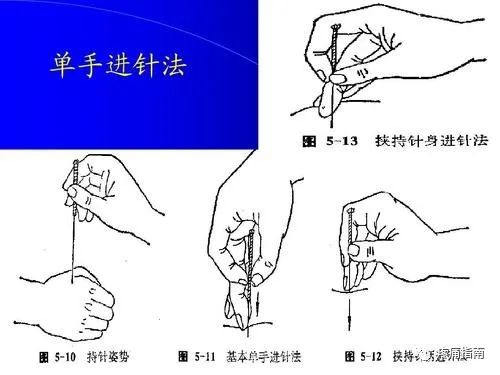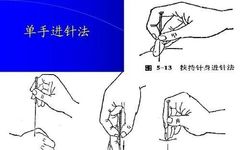
ClickBlue↑ to follow us!
Needle Holding Technique
(1) The Inserting Hand and the Pressing Hand
In needle operation, the right hand of the practitioner holding the needle is generally referred to as the “inserting hand” (刺手, cì shǒu), while the left hand that presses on the acupuncture point is called the “pressing hand” (押手, yā shǒu) or “holding hand” (压手, yā shǒu). The “Lingshu: Nine Needles and Twelve Origins” states, “The right hand is primarily for pushing, while the left hand holds and controls,” indicating that the role of the inserting hand is mainly to grasp the needle. During insertion, the strength of the arm, wrist, and fingers is concentrated in the inserting hand to allow the needle tip to quickly penetrate the skin, followed by the manipulation of the needle. The pressing hand’s role is primarily to stabilize the skin over the acupuncture point, ensuring that the needle accurately pierces the acupoint and that the long needle body has support to prevent shaking and bending. When inserting the needle, proper coordination between the inserting and pressing hands can reduce pain, facilitate smooth needle insertion, and adjust and enhance the sensation of the needle, thereby improving treatment efficacy. Ancient practitioners placed great importance on the coordination of both hands, as noted in the “Biao You Fu”: “The left hand is heavy and presses more, wanting to disperse Qi; the right hand is light and enters slowly, which is the reason for no pain,” which is indeed a piece of experiential advice.

(2) Needle Holding Posture
The posture of holding the needle resembles holding a brush, hence it is called the “brush-holding style” (执毛笔式, zhí máobǐ shì). Depending on the number of fingers used, it is generally divided into two-finger, three-finger, four-finger, and five-finger holding methods.
1. Two-finger holding method: This involves using the pads of the thumb and index finger of the right hand to grasp the needle handle, with the needle body forming a 90-degree angle with the thumb. This method is commonly used for short needles when needling shallow acupoints.
2. Multi-finger holding method: This involves using the pads of the thumb, index, middle, and ring fingers of the right hand to hold the needle handle, with the tip of the little finger resting against the skin beside the needle, supporting the needle body vertically. This method is generally used for deep needling with long needles.
Needle Insertion Techniques
Needle insertion techniques, also known as needling methods (刺针法, cì zhēn fǎ), refer to the various methods of inserting the needle into the subcutaneous layer of the acupoint under the close cooperation of the inserting and pressing hands. This is the primary operational technique in acupuncture. During insertion, attention must be paid to the coordination of finger strength and wrist strength, aiming for a painless or minimally painful insertion. There are many methods of needle insertion, categorized by speed, technique of insertion, posture of the pressing hand, and the use of insertion tools. Commonly used insertion methods include the following.
(1) Categorized by Insertion Speed
1. Rapid insertion method: This involves quickly piercing the skin with the needle tip when it is placed against the acupoint, using finger strength to penetrate the epidermis and insert the needle into the subcutaneous layer. This method is suitable for acupoints on the limbs and ear acupoints.
2. Slow insertion method: This involves gently piercing the skin with the needle tip when it is placed against the acupoint, using finger strength to slowly penetrate the epidermis and insert the needle into the subcutaneous layer. This method is suitable for acupoints on the head and body.
(2) Categorized by Insertion Technique
1. Direct insertion method: This involves placing the needle tip against the skin of the acupoint and directly inserting it into the subcutaneous layer without twisting or using other techniques.
2. Twisting insertion method: This involves placing the needle tip against the skin of the acupoint and slightly twisting it to insert the needle tip into the subcutaneous layer.
3. Flying insertion method: This involves placing the needle tip against the skin of the acupoint, using the thumb and index finger to twist the needle handle, and then quickly inserting the needle tip into the skin while releasing the fingers in a flying motion.
4. Flicking insertion method: This involves placing the needle tip against the skin of the acupoint and using the middle finger to flick the needle handle to quickly insert the needle tip into the subcutaneous layer.
(3) Categorized by Pressing Hand Posture
1. Single-hand insertion method: This involves using the thumb and index finger of the inserting hand to hold the needle, with the tip of the middle finger resting close to the acupoint. As the thumb and index finger apply downward pressure, the middle finger bends to assist in inserting the needle to the desired depth. This method is used for short needle insertion.
2. Two-hand insertion method: This involves the inserting and pressing hands working together to insert the needle. Common methods include the following:
(1) Claw-cut method: Also known as the finger-cut method, this is the most commonly used in clinical practice. It involves using the nail of the left hand’s thumb or index finger to press down on the acupoint, while the right hand holds the needle and inserts it close to the edge of the left hand’s nail.
(2) Pinching method: This involves using the thumb and index finger of the left hand to hold a disinfected cotton ball against the lower part of the needle body, exposing the needle tip. The right hand holds the needle handle, aligning the needle tip with the acupoint. As the needle approaches the skin, both hands coordinate to insert the needle using either the direct insertion or twisting insertion method until the desired depth is reached. This method is often used for long needle insertion.
(3) Stretching method: This involves spreading the fingers of the left hand, with the index and middle fingers placed apart over the acupoint, while the right hand holds the needle, inserting the needle tip between the index and middle fingers into the subcutaneous layer. During needling, the left hand’s index and middle fingers can hold the needle body to prevent bending, and this method is often used for deep needling with long needles. For areas with loose or wrinkled skin, the thumb and index fingers or the index and middle fingers can stretch the skin over the acupoint to tighten it for insertion. This method is often used for abdominal acupoint insertion.
(4) Pinch-lift method: This involves pinching the skin over the acupoint with the thumb and index finger of the left hand, while the right hand inserts the needle from the upper part of the pinched area. This method is mainly used for acupoints with thin skin and flesh, especially for facial acupoint insertion.
(4) Categorized by Insertion Tools
1. Needle tube insertion method: This involves using metal, plastic, or acrylic tubes of varying lengths to replace the pressing hand. A suitable length of flat-handle or tubular needle is placed inside the tube, with the needle’s tail exposed at the top. The lower end of the tube is placed over the acupoint, and the needle tip is inserted into the subcutaneous layer by tapping or pressing the needle’s tail with a finger, after which the tube is removed.
2. Insertion device method: This involves using a specially designed pen-like or toy gun-like insertion device, with a suitable length of flat-handle or tubular needle loaded inside. The lower end is placed over the skin of the acupoint, and the spring is released by pulling a trigger, causing the needle tip to quickly penetrate the subcutaneous layer, after which the insertion device is removed.
All of the above insertion methods should be flexibly selected based on the anatomical characteristics of the acupoint, the required depth of needling, and the specific requirements of the technique, aiming to facilitate insertion, achieve Qi, and minimize pain.
Content sourced from the internet; please contact us for any copyright issues.
Your likes are our motivation for progress!
↘↘↘

